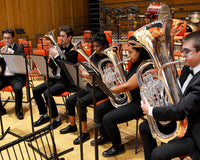"What violin size do I need?"
"Can my ten-year-old play a full size violin?"
"How do I size my child for a violin?"
"Does a small adult play a full-size violin or a 7/8?"
Making sure you buy the right size Violin (from Normans Musical Instruments obviously!) is just as important as buying the best quality instrument. The most important thing in deciding the correct size is that the student can comfortably play the instrument. To put ‘growth spurts’ into perspective, if your child starts on a 1/8 size violin at the age of 4 years old, you may have purchased multiple violins by the time they are 14! So value and quality is paramount. Welcome to Normans Musical Instruments; your saviour!Player's Arm Length
To accurately assess which size is correct for the player, run a measuring tape from the left side of the player's neck to their palm. Repeat this again but from neck the wrist. The arm must not be bent at the elbow and make sure the palm faces up at the ceiling. NECK - PALM: The neck to palm measurement indicates the largest size that would be appropriate. Only go larger than this size if the child is growing rather quickly and if you are certain the teacher will not object to the large violin. NECK - WRIST: The neck to wrist measurement provides a comfortable size. Suzuki teachers in particular are trained to teach players on a violin fitting this way (not too large). As previously stated, the most important thing in playing a ‘on the large size’ instrument is that the player can comfortably, potentially play in tune. Please note that even left-handed players play a regular, right-handed violin. Just imagine the performance ‘carnage’ with the bows hitting each other if you had a right-handed violinist sat next to a left-handed colleague!Violin Options
Violins are either full-size (4/4) or described fractionally, i.e. 1/10, 1/8, 1/4 etc. As an average rule, adults and children aged 11+ play full size instruments. The bows (which are provided with Forenza) match the size of the violin perfectly. So if you buy a ¾ size violin, you will receive a ¾ size bow… and deluxe case, straps, rosin etc.
Stuck between two different sizes?
Opt for the bigger size
Choosing to use a larger violin can be a wise choice if the student is growing rapidly or if you are paying a bit more to have a better quality, larger violin. Rather than buying two violins one after another, the larger violin would be used longer, thus it would make sense to invest a bit more money into it. If anything, the student really learns to stretch for their 4th finger notes and can aid excellent dexterity and intonation!Opt for the smaller size
The other argument though is always stay on the side of caution, and get the smaller violin. It is tempting to get the bigger size, figuring, "Oh, they’ll grow into it," but it can be frustrating for a child to work with an unwieldy violin that is too big, and importantly, too heavy! You want the child to feel in control of the violin. A violin that is too big may actually hurt to hold because of its weight, and it may throw off the mechanics of playing. The important thing here is that the student is able to or be very close to playing the 4th finger. If they can reach this fingering the violin will be usable. We're actually lucky that violins come in various sizes! An octave on a piano is always an octave, no matter how small the hands attempting to play it!
Here at Normans Musical Instruments we supply the six typical "fractional" sizes for violins, from smallest to largest: 1/10, 1/8, 1/4, 1/2, ¾, and full-size 4/4. So, don’t delay on the journey to Symphonic stardom… you might have a growth spurt!
We're actually lucky that violins come in various sizes! An octave on a piano is always an octave, no matter how small the hands attempting to play it!
Here at Normans Musical Instruments we supply the six typical "fractional" sizes for violins, from smallest to largest: 1/10, 1/8, 1/4, 1/2, ¾, and full-size 4/4. So, don’t delay on the journey to Symphonic stardom… you might have a growth spurt!



















